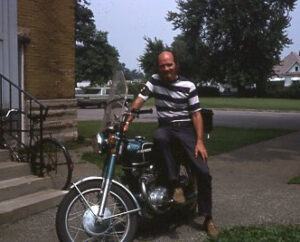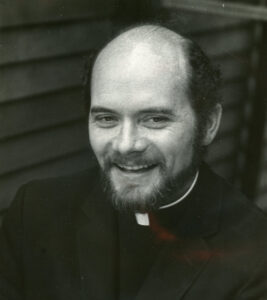
The author with friend at a protest against the School of the Americas, ca. 1990, recalling US training of the soldiers implicated in the El Mozote massacre in El Salvador. Photo from the author’s collection
Compiled by Janice Jayes from interviews she recorded between 2018 and 2023, in which Father Tom reflected on the many experiences that expanded his vision of moral responsibilities in the decades after his 1960 ordination.
Daniel Berrigan and the Challenges of Vatican II
In 1966 I became assistant pastor at St. Mary’s near Danville, where both my real-world education and my troubles with hierarchy began. The Vatican II documents were just coming out and I joined some local Protestant pastors to study the statements on peace and justice. It was a great lesson in ecumenicalism but also a bit disappointing. Many Catholics focused more on liturgical changes than the admonition to actively engage in building a just world.
Except for the nuns, that is. My observation was, in general, if you had a group of nuns in the parish they most likely knew more about Vatican II than the priests did. In the summer the nuns went off to workshops at places like Notre Dame, where they completed degrees or just visited with friends from the mother house. Notre Dame was just a hotbed of progressive discussion then, with exciting lectures and unusual sermons. I liked visiting friends studying there, and in 1966 I heard that the Jesuit priest Daniel Berrigan would be speaking on campus. Back in Danville I mentioned it to the nuns and the next thing I knew they all wanted to go. The priests I was with were not interested, but the nuns drove up with me for the talk.
Berrigan was famous in peace circles for his outspoken opposition to the Vietnam War. Why, he later asked, were Americans OK with having their government napalm children but scandalized when he, his brother and fellow priest Philip Berrigan, and seven others used napalm to burn draft cards, as they did in 1968? The “Catonsville Nine,” as they came to be called, welcomed the chance to publicize the participation of Catholic clergy in the anti-Vietnam War activism. Berrigan’s continued activism while on the run from the FBI (he even appeared at a rally at Cornell celebrating his “crime”!) became an embarrassment to the government but an inspiration to many others.
Eventually the FBI caught up with Berrigan on Block Island in August 1970. The men who looked like birdwatchers, in their yellow slickers and binoculars, were really watching Berrigan. One theologian wrote about the FBI searching for that rare species: Christianus Americanus.
Later I saw Berrigan again. I had read about a workshop at Siena House, the Michigan mother house for the Dominican Sisters, that would include Berrigan and William Stringfellow, the civil rights activist and lay theologian who had sheltered Berrigan. It was a small group, with just the sisters from the community and three priests from Marquette. After the day’s meetings Berrigan suggested that we priests, who were staying apart, should go out for dinner. So on two evenings we did, enjoying pizza, beer, and conversation. These kinds of moments sustained me and helped me return to parish work with new energy. Berrigan offered a model for living out the challenges of Vatican II.
The March on the Pentagon, 1969
In November, 1969 I decided to go to DC for the second moratorium protest against the Vietnam War. It was an act of conscience for me and the first time I wore my clerical collar at a protest. Tom Kelly, a priest I knew from seminary who was teaching at Bradley University, had inspired me with his account of wearing his collar when he joined the Selma marchers for the final leg of their journey in 1965. “You are the reason I get in trouble so much,” I told him later.
We were so excited. I was traveling to DC with four others, some nuns and other friends. When we got into DC there were about 100 dump trucks parked nose-to-tail around the White House as a barrier. On top of buildings along the route were military men with guns. It dawned on me that they weren’t hiding the guns, they wanted us to see them. It was a powerful contrast, the show of weapons and the cries for an end to the war.
We marched to the Pentagon and then back into DC. I wanted to stay, but I had to be back in time for morning mass in Danville, so we hopped in the car to head home. Even though I was back on time the trip to Washington was the last straw for some parishioners. They made some calls about me and shortly after that I was transferred to St. Matthew in Champaign. I didn’t last many months there before it was clear they also thought sermons on Vietnam and civil rights were outside my clerical role. I worried some of them might follow me down the aisle cheering on my last day there.

Royer traveled throughout the US on his motorcycle, visiting Trappist monasteries, national parks and distant friends
From Traitors to Prophets at the DNC, 1976
At the time criticizing the war in Vietnam was considered un-American and even traitorous. And yet, within a few years those prophetic voices against the Vietnam War were celebrated.
I saw this shift in 1976. I had received tickets to the Democratic National Convention (DNC) in Madison Square Garden where I sat so far into the upper reaches you really needed binoculars to see the stage. But it was still exciting. Carter was tying up the nomination, but one of the unresolved issues was whether to pardon those who had left the country to evade military service in Vietnam. There was a plan to force the issue by symbolically proposing some controversial figure as vice president, perhaps even Dan Berrigan, but in the end, they chose “draft dodger” Fritz Efaw. Efaw, who spent years in London organizing anti-war protests in front of the US embassy, was nominated as vice president.
And then Ron Kovic came out on the floor to second Efaw’s nomination.
It was normal for delegates to not pay a lot of attention to what was going on onstage, but when Kovic came out in his wheelchair, the hubbub died away. Everyone knew who he was. His book, Born on the Fourth of July, had come out earlier that year. To see this young man—barely thirty years old, who had been paralyzed in Vietnam—roll across the stage was powerful. As he began to recite there was absolute silence.
“I am the living death,
a Memorial Day on wheels.
I am your Yankee Doodle Dandy,
your John Wayne come home,
your Fourth of July firecracker
exploding in the grave.”
Kovic spoke of the bravery of the shadow population, men like Efaw who had refused to fight in an unjust war. There was a little bit of booing but mostly just stunned silence as the draft dodger and the paralyzed veteran embraced.
Afterwards I went down to meet him. I passed all kinds of people in the crowd, including Hubert Humphrey, but I was on a mission. By the time I got there he was alone on the floor, basking in the moment in a sea of paper debris.

The author speaking at a 2007 teach-in against the US war in Iraq
We had a little talk, all alone on the floor there in Madison Square Garden. I told Kovic I loved his speech and admired him for standing up to the anger and criticism. He asked who I was and what I did, and I told him I was a Catholic priest. He paused, “Wow,” he said, in a pleased way, “That’s pretty interesting.”
And I thought, Yes. Yes, it is pretty interesting.

Reverend Thomas Royer (1935–2024) was pastor of St. Mary Catholic Church in Champaign for more than thirty years. He was well known for his active involvement in local and international social justice causes.
922 total views, 2 views today